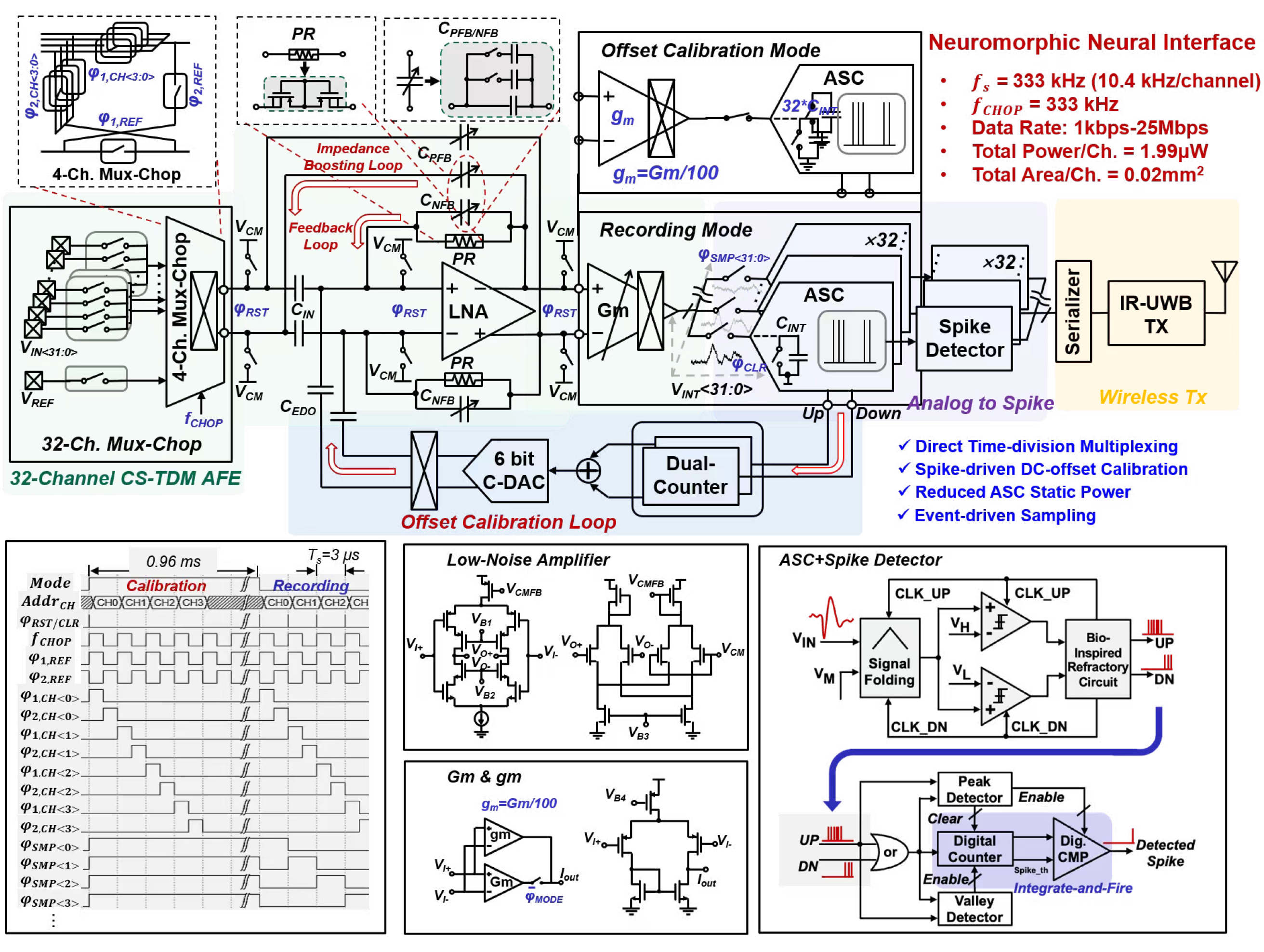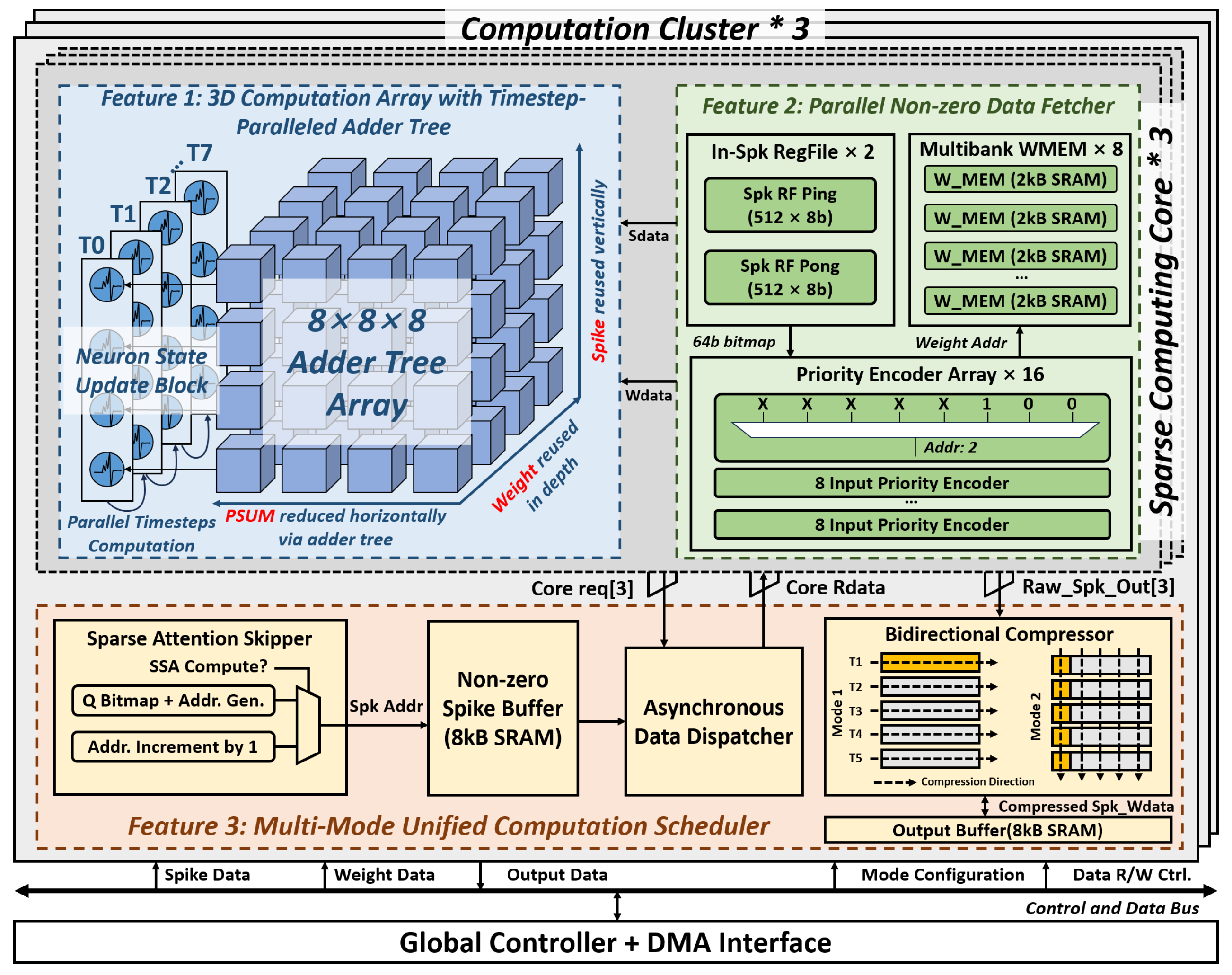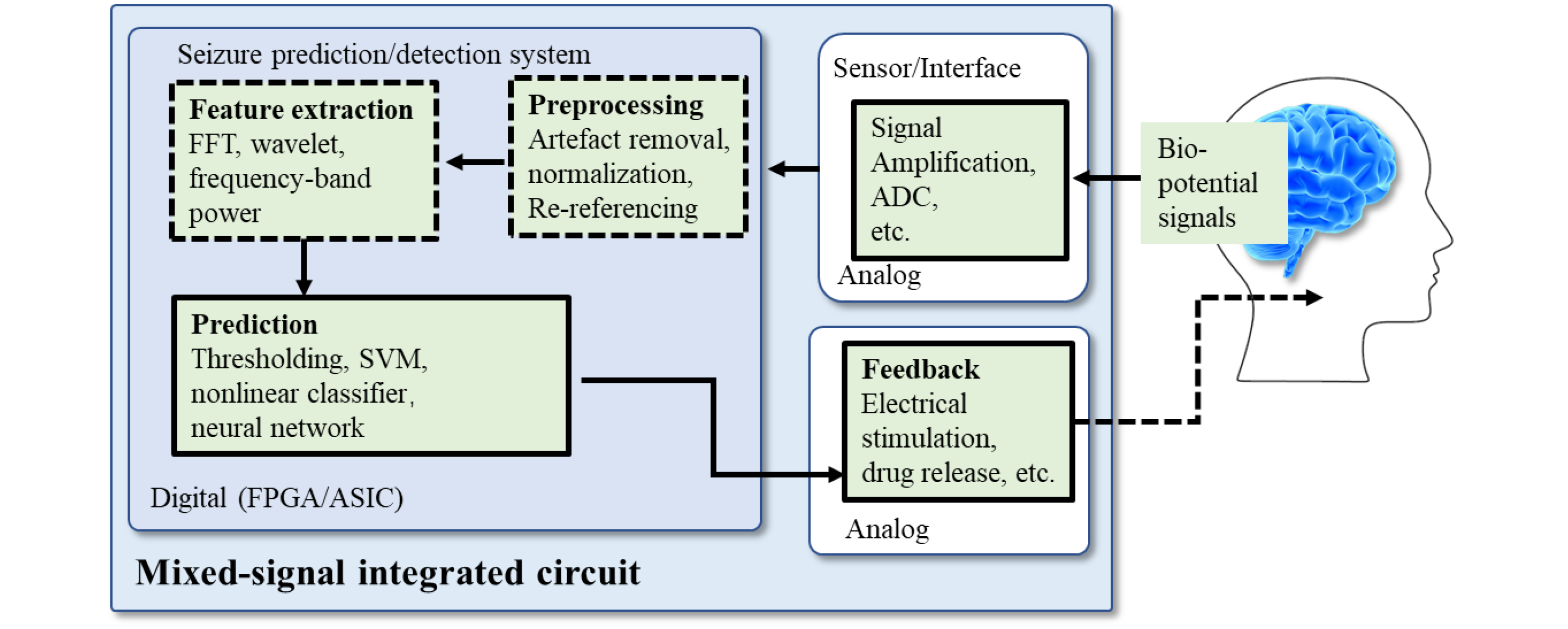High throughput neural recording
The high throughput neural recording chip is a pivotal component in our quest to effectively capture and transmit brain signals across hundreds to thousands of channels [1]. A primary challenge in this domain is the significant power consumption attributed to the high-volume data transmission inherent in current neural recording chips.
To address this, our team at CenBRAIN Neurotech has innovatively applied compressive sensing and artificial intelligence techniques to achieve 16-fold lossless compression of sampled data [2]. This work significantly reduces overall system power consumption. Additionally, we've embraced a co-design strategy that synergizes both hardware and software elements. This approach facilitates on-chip compression under stringent low power constraints [3], making it possible to transmit neural signals from hundreds of channels efficiently, even using low-power Bluetooth technology.

Further enhancing our system's efficiency is the integration of event-driven sampling directly on the chip [4]. This method not only preserves vital spike potentials but also enables data compression by several orders of magnitude [5]. In our pursuit of optimizing data rates, we're also exploring communication modules based on impulse radio ultra-wideband (IR-UWB) technology. This advanced communication protocol offers the potential to significantly improve the energy efficiency of data transmission, further reducing energy consumption during the data transfer process. The above technology has been integrated in our recent work published in [6], which achieves state-of-the-art neural recording performance with 0.0032mm and 1.38μW per channel cost.
AI-assisted Neural Decoding and Applications
Our research is deeply focused on the challenging task of deciphering human intentions through the analysis of hundreds of thousands of neural signal channels obtained from the brain. With the assistance of artificial intelligence, our project aims to precisely decode these intentions, thereby aiding individuals with disabilities in regaining their abilities in movement and language. A significant aspect of our work involves collaborating with the NLP lab at the School of Engineering to develop a system that can interpret Chinese language directly from brain signals. Our innovative system successfully translates speech-related stereo electroencephalography (sEEG) signals into complete sentences in Chinese, ensuring the accurate interpretation of all Chinese pronunciations [7]. Furthermore, our efforts extend to addressing some of the critical challenges faced in the field of brain-computer interfaces (BCI), such as dealing with the scarcity of data[8], accommodating individual variations [9], and integrating multi-modal data, all through the application of AI technologies.

Neuromorphic Computing Chip and Application
CenBRAIN Neurotech is at the forefront of neuromorphic computing, utilizing spiking neural networks to design processors that are significantly more energy-efficient and performant than traditional processors. This makes them ideal for edge computing applications. Our research encompasses a variety of bio-signal processing tasks, including low-power ECG signal processing [10], epilepsy signal processing [11], and retinal prostheses [12-14], with a general framework for diverse bio-signal processing applications [15].

We have developed on-chip learning and multimodal neuromorphic processors [16-18] tailored for the power and performance needs of wearable and implantable edge devices. Our goal extends to efficiently integrating a large number of neurons on neuromorphic chips for more complex tasks. We're exploring NoC routing protocols and circuits in multi-core neuromorphic processors to minimize latency and power consumption [19]. To address power and latency overheads and counteract throughput reduction due to sparse data, we have designed a neuromorphic processing core with high parallelism and non-structured sparse sensing. This design achieves an impressive performance of 0.078pJ/SOP [20]. Looking ahead, we plan to apply our massively integrated neuromorphic chips and systems in advanced fields like unmanned vehicles, robots, and drones.
Closed-loop neuromodulation
Addressing this, here in CenBRAIN, we propose a new path to achieve precise closed-loop modulation through on-chip integration of micro-watt-level (μW) low-power neural networks [21, 22]. Our team has delved into various neural signal processing algorithms, including convolutional neural networks (CNNs) [23, 24], binary neural networks (BNNs) [25], and spiking neural networks (SNNs) [26]. These advanced methods have consistently outperformed traditional techniques in classification tasks. Further innovation has been achieved in network efficiency. By merging neural signal characteristics with advanced

techniques in network architecture search, pruning, and quantization, we have compressed our network size to below 100KB [27]. This advancement underpins the design of our custom-built, low-power bio-signal processing chip [28]. This chip supports multiple network types through its reconfigurable design and operating at the micro-watt level with an event-driven mechanism. It stands as a cornerstone for the next generation of intelligent, closed-loop neural modulation systems.
References
[1]
J. Chen, M. Tarkhan, H. Wu, F. Noshahr, J. Yang, M. Sawan, "Recent trends and future prospects of neural recording circuits and systems: A tutorial brief," IEEE Transactions on Circuits and Systems II: Express Briefs, 2022.[2]
D. Wu, Y. Shi, Z. Wang, J. Yang, M. Sawan, "C2SP-Net: joint compression and classification network for epilepsy seizure prediction," IEEE Transactions on Neural Systems and Rehabilitation Engineering, 2023.[3]
D. Wu, S. Zhao, J. Yang, M. Sawan, "Software-Hardware Co-Design for Energy-Efficient Continuous HealthMonitoring Via Task-Aware Compression," IEEE Transactions on Biomedical Circuits and Systems, 2023.[4]
J. Chen, H. Wu, J. Yang, M. Sawan, "A 97 fJ/Conversion Neuron-ADC with Reconfigurable Sampling and Static Power Reduction," 2022 IEEE Asia Pacific Conference on Circuits and Systems (APCCAS), 2022.[5]
J. Chen, H. Wu, X. Liu, R. Eskandari, F. Tian, W. Zou, C. Fang, J. Yang, M. Sawan, "NeuroBMI: A New Neuromorphic Implantable Wireless Brain Machine Interface with A 0.48 µW Event-Driven Noise-Tolerant Spike Detector," 2023 IEEE 5th International Conference on Artificial Intelligence Circuits and Systems (AICAS), 2023.[6]
C. Fang, Z. Shen, S. Zhao, C. Wang, F. Tian, J. Yang, M. Sawan, “A 0.078 pJ/SOP Unstructured Sparsity-Aware Spiking Attention/Convolution Processor with 3D Compute Array,” 2024 IEEE Custom Integrated Circuits Conference (CICC), 2024.[7]
C. Feng, L. Cao, D. Wu, E. Zhang, T. Wang, X. Jiang, C. Zhou, J. Chen, H. Wu, S. Lin, Q. Hou, C. Lin, J. Zhu, J. Yang, M. Sawan, Y. Zhang, "A high-performance brain-sentence communication designed for logosyllabic language," bioRxiv, 2023-11.[8]
Y. Xu, J. Yang, M. Sawan, “Multichannel synthetic preictal EEG signals to enhance the prediction of epileptic seizures,” IEEE Transactions on Biomedical Engineering, 2022.[9]
D. Wu, J. Yang, M. Sawan, “Bridging the gap between patient-specific and patient-independent seizure prediction via knowledge distillation,” Journal of Neural Engineering, 2022.[10]
J. Chen, F. Tian, J. Yang, M. Sawan, "An event-driven compressive neuromorphic system for cardiac arrhythmia detection," 2022 IEEE International Symposium on Circuits and Systems (ISCAS), 2022.[11]
F. Tian, J. Yang, S. Zhao, M. Sawan, "A New Neuromorphic Computing Approach for Epileptic Seizure Prediction," 2021 IEEE International Symposium on Circuits and Systems (ISCAS), 2021.[12]
C. Wang, J. Yang, M. Sawan, "NeuroSEE: A Neuromorphic Energy-Efficient Processing Framework for Visual Prostheses," IEEE Journal of Biomedical and Health Informatics, 2022.[13]
C. Wang, C. Fang, Y. Zou, J. Yang, M. Sawan, "SpikeSEE: An energy-efficient dynamic scenes processing framework for retinal prostheses," Neural Networks, 2023.[14]
C. Wang, D. Wu, C. Fang, J. Yang, M. Sawan, “Exploring Effective Stimulus Encoding via Vision System Modeling for Visual Prostheses,” The 12th International Conference on Learning Representation (ICLR), 2024.[15]
D. Wu, Y. Shi, Z. Wang, J. Yang, M. Sawan, "C2SP-Net: joint compression and classification network for epilepsy seizure prediction," IEEE Transactions on Neural Systems and Rehabilitation Engineering, 2023.[15]
F. Tian, J. Yang, S. Zhao, M. Sawan, "NeuroCARE: A generic neuromorphic edge computing framework for healthcare applications," Frontiers in Neuroscience, 2023.[16]
C. Fang, Z. Shen, F. Tian, J. Yang, M. Sawan, "A Compact Online-Learning Spiking Neuromorphic Biosignal Processor," 2022 IEEE International Symposium on Circuits and Systems (ISCAS), 2022.[17]
C. Fang, F. Tian, C. Wang, J. Yang, M. Sawan, "A 217.8 MSOPs/W FPGA-based Online Learning SNN Processor Using Unified Event-Driven Structure and Topology Aware Data Reuse Strategies," 2022 IEEE Asian Solid-State Circuits Conference (A-SSCC), 2022.[18]
C. Fang, C. Wang, S. Zhao, F. Tian, J. Yang, M. Sawan, "A 510μW 0.738-mm2 6.2-pJ/SOP Online Learning Multi-Topology SNN Processor with Unified Computation Engine in 40-nm CMOS," IEEE Transactions on Biomedical Circuits and Systems, 2023.[19]
Z. Shen, C. Fang, F. Tian, J. Yang, M. Sawan, "PN-TMS: Pruned Node-fusion Tree-based Multicast Scheme for Efficient Neuromorphic Systems," 2023 IEEE 5th International Conference on Artificial Intelligence Circuits and Systems (AICAS), 2023.[20]
J. Chen, H. Wu, R. Eskandari, X. Liu, S. Lin, Q. Hou, F. Tian, W. Zou, J. Yang, M. Sawan, “A Neuron-Inspired 0.0032mm2-1.38μW/Ch Wireless Implantable Neural Interface with Direct Multiplexing Front-End and Event-Driven Spike Detection and Transmission,” 2024 IEEE Custom Integrated Circuits Conference (CICC), 2024.[21]
J. Yang, M. Sawan, "From Seizure Detection to Smart and Fully Embedded Seizure Prediction Engine: A Review," IEEE Transactions on Biomedical Circuits and Systems, 2020.[22]
S. Zhao, C. Fang, J. Yang, M. Sawan, "Emerging energy-efficient biosignal-dedicated circuit techniques: A tutorial brief," IEEE Transactions on Circuits and Systems II: Express Briefs, 2022.[23]
Y. Xu, J. Yang, S. Zhao, H. Wu, M. Sawan, "An End-to-End Deep Learning Approach for Epileptic Seizure Prediction," 2020 2nd IEEE International Conference on Artificial Intelligence Circuits and Systems (AICAS), 2020.[24]
Z. Wang, J. Yang, M. Sawan, "A Novel Multi-scale Dilated 3D CNN for Epileptic Seizure Prediction," 2021 IEEE 3rd International Conference on Artificial Intelligence Circuits and Systems (AICAS), 2021.[25]
S. Zhao, J. Yang, Y. Xu, M. Sawan, "Binary Single-Dimensional Convolutional Neural Network for Seizure Prediction," 2020 IEEE International Symposium on Circuits and Systems (ISCAS), 2020.[26]
F. Tian, J. Yang, S. Zhao, M. Sawan, "A New Neuromorphic Computing Approach for Epileptic Seizure Prediction," 2021 IEEE International Symposium on Circuits and Systems (ISCAS), 2021.[27]
S. Zhao, J. Yang, M. Sawan, "Energy-efficient neural network for epileptic seizure prediction," IEEE Transactions on Biomedical Engineering, 2021.[28]
S. Zhao, J. Yang, J. Wang, C. Fang, T. Liu, S. Zhang, M. Sawan, "A 0.99-to-4.38 μJ/class Event-Driven Hybrid Neural Network Processor for Full-Spectrum Neural Signal Analyses," IEEE Transactions on Biomedical Circuits and Systems, 2023.[29]
S. Zhao, J. Yang, J. Wang, C. Fang, T. Liu, S. Zhang, M. Sawan, "A 0.99-to-4.38 μJ/class Event-Driven Hybrid Neural Network Processor for Full-Spectrum Neural Signal Analyses," IEEE Transactions on Biomedical Circuits and Systems, 2023.







